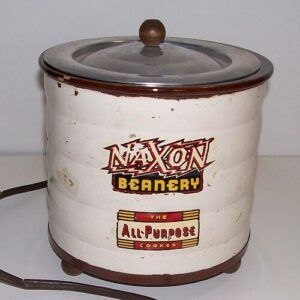Crock-Pot remains popular 50 years after its debut in Kansas City

Chili in the Crock-Pot is as much a part of fall as cooler weather and football games. The popular appliance can trace its roots to Kansas City.
Before the Crock-Pot was a household name, it was called the Naxon Beanery and offered a more specific, bean-centric purpose patented by prolific inventor Irving Naxon. The Beanery originally was intended for a Jewish stew of meat and beans, which is slowly cooked on Fridays in preparation for the Sabbath. It also helped millions of Church-goers have a meal to come home to after Sunday church.

The “bean pot” never caught on with the masses, so in 1970, Naxon sold his device to Rival Manufacturing. The Kansas City company already was famous for kitchen gadgets such as the Juice-O-Mat juicer and the Knife-O-Mat sharpener. Purchasing the slow cooker was an afterthought for Rival.
“No one paid any attention to it,” Rival president Isidore Miller said in 1981. “We almost forgot about it.”
Miller handed the Beanery over to Rival’s test kitchen, where an employee named Marilyn Neill had an immediate epiphany: This can cook way more than just beans. “From that point on, I believe they gave those home economists in the test kitchen a lot more attention than they ever did before,” said Roxanne Wyss, a former Rival home economist.
The renamed Crock-Pot made its official debut in 1971 at the National Housewares Show in Chicago, sharply dressed up in colors like avocado and harvest gold. Print ads and television commercials flaunted the Crock-Pot as a miraculous, time-saving device, assuring women in no uncertain terms: You can have it all. The pitch worked. Crock-Pot sales hit $2 million the first year it was introduced. Four years later, that number exploded to $93 million.
“When a company comes up with a product like a Crock-Pot, those are kind of a once-in-a-lifetime product development for a corporation,” Wyss told a local radio station. “And it does then put a tremendous amount of pressure and weight on that home economics department.”
The Crock-Pot came with its own cookbook
Rival’s home economists took on the task of teaching people how to use this novel appliance. The internet didn’t exist, of course, so employees like Wyss spent hours testing soups, stews and roasts for inclusion in the recipe book that accompanied each brand-new Crock-Pot.
“The food was probably Midwest in that you look at who was in those test kitchens,” said Kathy Moore, another former Rival home economist. “But at the same time, that was comforting, old-fashioned food. And beef stew transcends all of the United States.”
 But the Crock-Pot was just one of Naxon’s over 200 inventions. You may have used the electric frying pan or the hula lamp, the predecessor of the Lava Lamp. If you’ve ever seen an electronic sign about merging traffic or watched New Year’s Eve in New York and seen the scrollers on Times Square broadcast as the ball drops you can thank the telesign–also invented by Naxon.
But the Crock-Pot was just one of Naxon’s over 200 inventions. You may have used the electric frying pan or the hula lamp, the predecessor of the Lava Lamp. If you’ve ever seen an electronic sign about merging traffic or watched New Year’s Eve in New York and seen the scrollers on Times Square broadcast as the ball drops you can thank the telesign–also invented by Naxon.
But for most, the Crock-Pot remains his signature creation. Half a century after its debut, nearly 12 million slow cookers are still purchased every year.
–Alan Goforth | Metro Voice
Metro Voice is an Amazon Affiliate. You can learn more about the many varieties of Crock-Pots below:






